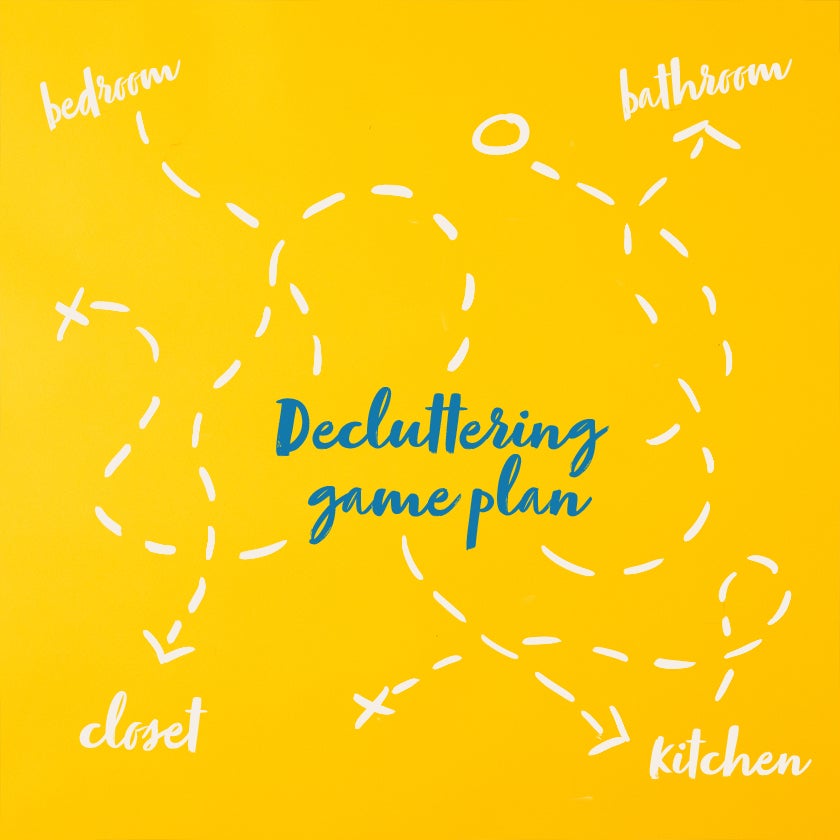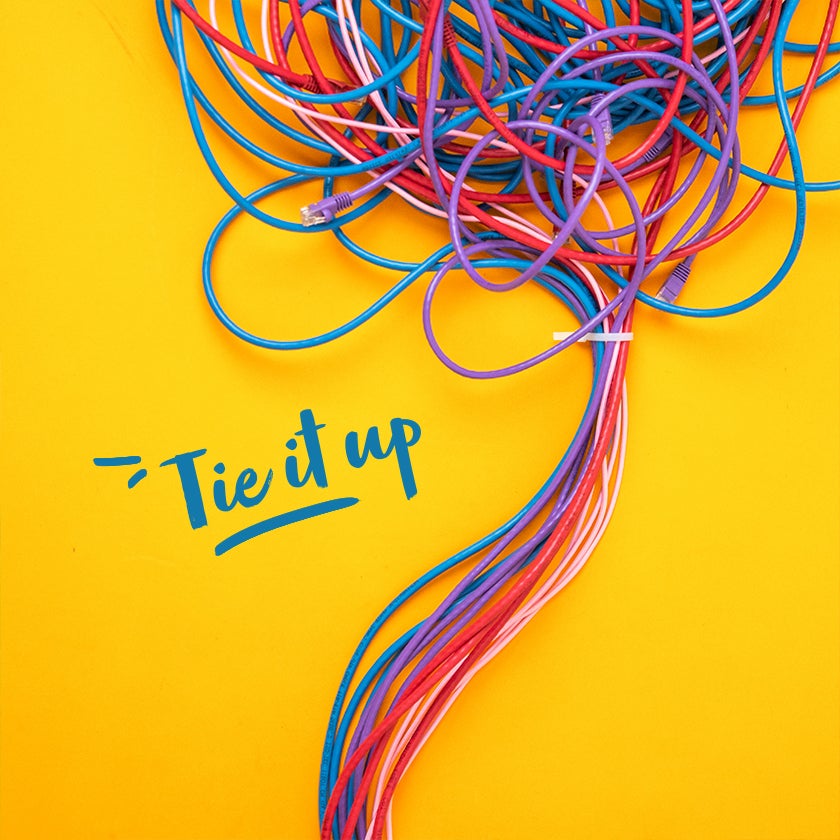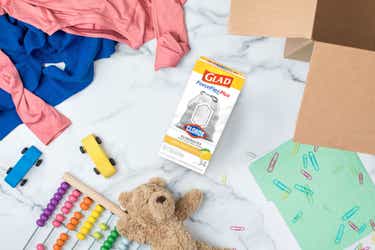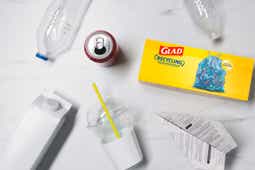Where to Start If You Want to Declutter Your Home
Making the decision to declutter your home can feel like a huge step in and of itself, but actually getting started is a much larger obstacle. Particularly if you have a big decluttering job ahead of you, knowing where to begin the process can be overwhelming — which is why coming up with a decluttering game plan is so essential.

Before you dive in, figure out what your decluttering goal is. Do you merely want to get rid of visible mess, or do you want to create entirely new household organizational systems to use going forward? Knowing what your end goal is can help you prioritize tasks and figure out your next steps.
Another trick to kickstart your decluttering? Start with what you feel is the easiest room first. For example, if you know you need to do an overhaul of your entire wardrobe, don’t tackle your bedroom and closet first. If you begin with a simpler decluttering job — say, cleaning out and reorganizing your spice rack — it can empower and motivate you to tackle bigger decluttering projects.
The Best Way to Tackle a Cluttered Room
As you get ready to start the decluttering process, it helps to have a system in place that you can use as you clean and reorganize. One super simple, straightforward option is the “Four-Box Method” — using four boxes or storage bins, you can streamline your decluttering job. Here’s a breakdown of how just four boxes can make tackling a cluttered room a breeze.
Box 1: Trash
The first box will be your designated trash dump. Any items you want to get rid of that aren’t worth donating or selling go here. Pro tip: to save yourself a step, go ahead and use Kitchen ForceFlex MaxStrength™ Bags Fresh Clean Scent instead of a box so you can take your trash straight to the curb after cleaning up. And don’t forget to recycle items whenever possible! Check out Glad’s guide to what can and cannot be recycled to learn more.
Box 2: Give Away/Sell
Next, designate a box for items that are still in OK condition, but that your household could do without — like old books or toys, for example. Whether you want to give these things away to family/friends, donate them to charity, or sell them in a yard sale to make a little extra money is totally up to you.
Box 3: Storage
This box is for things that you can’t or don’t want to get rid of, but that you aren’t in need of on a day-to-day basis (think things like seasonal decorations). It’s also a good idea to make an inventory of items that you’re putting in storage as you go — that way, you won’t be left wondering what exactly is taking up space in your garage or attic down the line.
Box 4: Put Away
Lastly, have a box ready to place any items that need to be kept in your house, but relocated to their proper place. If you want to get really organized, you can have a few smaller boxes — one each for places like your bathroom, kitchen, or bedrooms — and sort misplaced items into their “homes” to save yourself the hassle later.
Want one last decluttering pro tip? If you have the need for it, you can add a fifth box to this method: one for items that can be repaired/replaced rather than tossed out or donated, like a watch that needs a new battery.
How to Declutter Your Bedroom
Tackling your bedroom may seem like an overwhelming project — especially if you’re just learning how to declutter efficiently. To start your bedroom decluttering off on the right foot, spend a few minutes tidying it up first: make your bed and pick up any dirty clothes that might be strewn across the floor. Once the visible, day-to-day mess is out of the way, you’ll be more motivated to move on to these problem areas.
Nightstands
If you have a nightstand that you use as a catch-all storage space for your clutter, now’s the time to go through it with a fine-toothed comb. Unless you need access to something before bed — like a sleep mask or earplugs — the nightstand is not the place for it. Don’t forget to declutter the top of your nightstand, too: clear off anything that isn’t essential (lamps or alarm clocks, for example) and minimize the knickknacks and décor you keep displayed on top for a less cluttered look and easier cleaning.
Dressers/Drawers
Is there anything worse than messy, overstuffed drawers? If you’re tired of having to dig through a sea of disorganized clothes to find what you need every day, it’s time to sort each item of clothing in your dresser using the Four-Box Method. A good rule of thumb: if you haven’t worn it in at least six months or it no longer fits, it doesn’t belong in your dresser drawers. Once you’ve pared things down, try folding your clothes into small rectangles and placing them face-up — instead of stacked atop one another — so you can easily see each item when you pull the drawer open.
Closets
If you want to really declutter your home, it’s necessary to spend a significant chunk of time decluttering your closets, as they can be major havens for clutter. Before you start sorting things using the Four-Box Method, it’s a good idea to remove everything from your closet and lay it all out so you can easily see exactly what you have. This is also a good opportunity to wipe down any shelves and surfaces in your closet that rarely get cleaned.
Next, ask yourself a few key questions as you decide what items you want to keep: when is the last time I wore this? Does this piece of clothing make me feel good when I wear it? Do I have something similar to this that I like more? It’s also a good rule of thumb not to keep something for “someday” — like if it no longer fits but you’re keeping it around just in case it fits again one day. That mindset is how clutter accumulates!
When you’re putting away things you want to keep after the purge, make sure to put your most-worn items in easily accessible spots, and then organize things however works best for you — whether that’s by color, season, or occasion.
Decluttering Ideas for Your Bathroom
Although bathrooms can be relatively small spaces compared to other rooms in your home, that doesn’t mean they can’t accumulate just as much clutter. Here are some decluttering ideas that will make your bathroom more organized than ever before.

Purge Your Beauty Products
Some of the biggest culprits of bathroom clutter are beauty products: makeup, skincare products, hair accessories, and more. If you haven’t used a product in six months to a year, toss it into a Glad® Small Scented Garbage Bag for disposal. It’s also good to break the habit of accumulating duplicates of things — for example, don’t open a new bottle of shampoo if you still have a couple days’ worth of product left in an old one.
Take Stock of Your Medicine Cabinet
You might open your medicine cabinet every day, but when’s the last time you actually cleaned it out? Take everything off the shelves, and toss anything that’s old or no longer usable — like stretched out hair ties or expired medications — then wipe down the inside before returning the items you’re keeping to your medicine cabinet.
Create Hidden Spots for Storage
Short on storage space? There are plenty of handy tricks that can create a more organized bathroom instantly. If you keep finding bobby pins strewn all over the place, try attaching a magnetic strip to the inside of a cabinet door and sticking your bobby pins on it for easy access. You can also use a file organizer as a handy spot for your hair tools by attaching it to a wall or the side of a sink cabinet. For smaller items like makeup brushes, cotton balls, and cotton swabs, have labeled jars dedicated for each and then set them on your counter or a shelf for easy access that won’t look messy.
Your Living Room Declutter Checklist
Your living room is where a lot of household action takes place — meaning it can be a magnet for clutter from everyone in your family. If you want to make your living room a clutter-free zone, follow this simple, three-step declutter checklist.
Step 1: Sort Through Toys, Books and Magazines
If your living room acts as de facto storage for books, magazines, and children’s toys, it’s a good idea to do a sweep of these items and sort them using the Four-Box Method. Donate old books to a local library or school, recycle old magazines, and toss any toys with too much wear and tear to donate or sell.
Step 2: Reduce the Amount of Knickknacks
There’s nothing wrong with enjoying décor in your home, but too many knickknacks in your living room can make it harder to make use of the space — and harder to clean around, too. Take stock of things you have sitting out on tables and shelves, and decide what you might be willing to part with: are there old picture frames, throw blankets, or potted plants you no longer care for?
Step 3: Create a Permanent Storage Spot for Everyday Items
Instead of just leaving things lying on your coffee table, designate a basket for everyday items — like remotes, chargers, and video game controllers — and then stow the basket under an end table or in a drawer for easy access.
Decluttering Tips for Your Home Office
There’s nothing less motivating than trying to get work done in a home office that’s messy and disorganized. If that sounds a little too familiar, check out these quick and easy decluttering tips for your home office that will help make it a productivity paradise.
Remove Items That Don’t Belong
The first step of decluttering a messy home office? Removing or putting away any personal/household items that don’t belong there, such as toys, dishes, or workout gear. Your work space should be for work only — non-work-related items act as reminders of other responsibilities, which can be distracting when you need to focus on work.
Sort Through Documents and Papers
If your desk is barely visible thanks to a jumble of papers, now’s the time to sort through them. Make three piles: one for papers to shred or toss, one for documents to file away, and one for things you need to take action on. If most of your work-related documents are digital, go ahead and spend some time organizing and cleaning those up, too. Even though digital clutter isn’t visible, it can be just as detrimental to your productivity.
Organize Your Desk Drawers
One simple hack that can work wonders? Organize your desk drawers according to what items you use most frequently. For example, you might fill your topmost drawer with everyday items — like a notepad, pens or phone charger — while the bottom drawer is home to things like your hole punch or envelopes. Pro tip: Within each drawer, have the most used items towards the front for easy access.
Clean Up Unruly Cords/Cables
Just the thought of a tangled knot of cords can be stressful — and your home office is the last place you want to feel stressed. One of the easiest decluttering tips for a home office is tying cords and cables together with zip ties so they stay together and look more streamlined. Once they’re together in one convenient bunch, you can tape or hook them under or behind your desk so they’re out of sight and out of mind.





